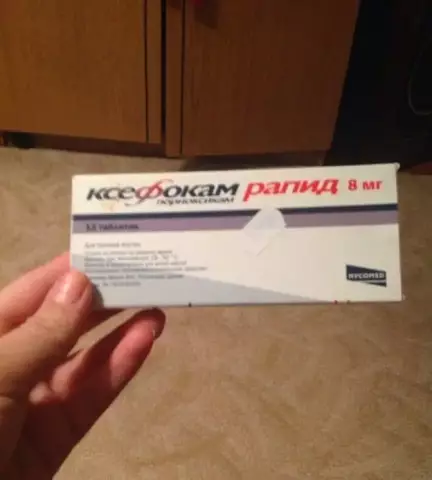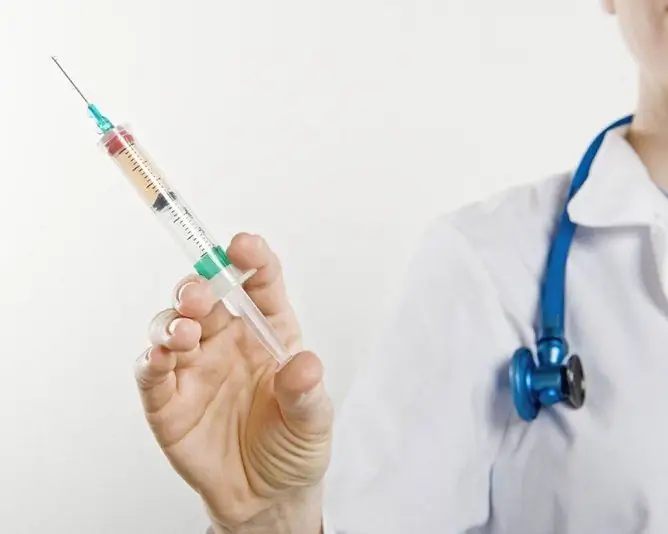- Author Rachel Wainwright [email protected].
- Public 2023-12-15 07:39.
- Last modified 2025-11-02 20:14.
Cefamezin
Cefamezin: instructions for use and reviews
- 1. Release form and composition
- 2. Pharmacological properties
- 3. Indications for use
- 4. Contraindications
- 5. Method of application and dosage
- 6. Side effects
- 7. Overdose
- 8. Special instructions
- 9. Application during pregnancy and lactation
- 10. Use in childhood
- 11. In case of impaired renal function
- 12. Drug interactions
- 13. Analogs
- 14. Terms and conditions of storage
- 15. Terms of dispensing from pharmacies
- 16. Reviews
- 17. Price in pharmacies
Latin name: Cefamezin
ATX code: J01DB04
Active ingredient: cefazolin (Cefazolin)
Manufacturer: KRKA, d.d. (KRKA, dd) (Slovenia)
Description and photo update: 2020-01-04

Cefamezin is a first generation cephalosporin antibacterial drug that has a bactericidal effect.
Release form and composition
The drug is produced in the form of a powder for the preparation of a solution for intravenous (i.v.) and intramuscular (i.v.) administration: a loose mass of white or white with a yellow tint (in glass transparent bottles with a capacity of 10 ml, in a cardboard box 1 bottle and instructions for the use of Cefamezin).
1 vial contains the active ingredient: cefazolin sodium - 1051 mg, which is equivalent to 1000 mg of cefazolin.
Pharmacological properties
Pharmacodynamics
Cefamezin is an antibacterial drug for parenteral use. Its active substance, cefazolin, is a first generation antibiotic of the cephalosporin series, has a wide spectrum of bactericidal action.
The following bacteria are susceptible to cefazolin:
- gram-positive microorganisms: Staphylococcus aureus (strains producing and not producing penicillinase), Staphylococcus epidermidis, methicillin-resistant strains of Staphylococcus speciales (spp.), Streptococcus pyogenes, Streptococcus pyogenescus (beta-hemolytic A), Streptococcus pneumoniae Bacillus (beta-hemolytic A), Streptococcus pneumoniae Bacillus Bacillus;
- gram-negative microorganisms: Neisseria gonorrhoeae, Neisseria meningitidis, Shigella spp., Escherichia coli, Salmonella spp., Proteus mirabilis, Enterobacter aerogenes, Klebsiella species, Haemophilus influenzae, Spirochaeta spp., Treponema spp.
Cefamezin is inactive against indole-positive strains Proteus spp., Serratia spp., Enterobacter cloacae, Providencia rettgeri, Morganella morganii, Mycobacterium tuberculosis, Acinetobacter spp., Pseudomonas aeruginosa.
Pharmacokinetics
After intramuscular and intravenous administration, cefazolin is rapidly absorbed. Its maximum concentration (C max) in the blood after i / m administration is reached after 1 hour. At a dose of 500 mg or 1000 mg, it reaches 0.037 mg / ml or 0.064 mg / ml, respectively, and after 8 hours - 0.003 mg / ml or 0.007 mg / ml. After intravenous administration at a dose of 1000 mg, C max of cefazolin after 5 minutes is 0.185 mg / ml, after 8 hours - 0.004 mg / ml.
The antibiotic is actively distributed in tissues and body fluids. In therapeutic concentrations, it accumulates in bones, bile, tonsils, urine, pleural exudate, peritoneal, pericardial and synovial fluids.
In the normal state of the bile ducts, the concentration of cefazolin in the bile is 5 times higher than the level in the blood serum. In patients with obstruction of the bile ducts, the content of cefazolin in the bile is lower than in the serum.
Does not overcome the blood-brain barrier, penetrates the placental barrier (from 35 to 69% of cefazolin contained in the mother's plasma is found in the fetal plasma). It is excreted in breast milk in low concentrations (against the background of the introduction of 2000 mg of cefazolin, its concentration in breast milk after 3 hours varies from 1.2 to 1.5 ng / ml).
Cefazolin is not metabolized in the body.
Half-life (T 1/2): with intramuscular administration - about 2 hours, with intravenous administration - 1.8 hours.
It is excreted mainly through the kidneys, during the first 24 hours 70-80%, of which in the first 6 hours up to 60% of the administered dose. In the urine, high concentrations of cefazolin are observed, with the introduction of 500 mg and 1000 mg C max, respectively - 2400 ng / ml and 4000 ng / ml.
Indications for use
The use of Cefamezin is indicated for the treatment of the following infectious and inflammatory diseases caused by bacteria sensitive to cefazolin:
- otorhinolaryngological infections, infections of the upper and lower respiratory tract;
- kidney and urinary tract infections;
- infections of the pelvic organs and genitals (including syphilis and gonorrhea);
- infectious pathologies of bones and joints (including osteomyelitis);
- peritonitis, sepsis, endocarditis;
- dermatological infections.
In addition, the drug is prescribed as perioperative prophylaxis in surgery.
Contraindications
Absolute:
- period of pregnancy;
- lactation;
- the neonatal period in children, including premature babies;
- an indication of a history of hypersensitivity to cephalosporins, penicillins, carbapenems.
With caution, injections of Cefamezin should be prescribed for colitis and other diseases of the gastrointestinal tract, moderate and severe renal failure, as well as for the treatment of children under the age of 1 year.
Cefamezin, instructions for use: method and dosage
A ready-made solution of Cefamezin is used parenterally, by intramuscular or intravenous (bolus or drip) administration.
For intramuscular administration, 0.9% sodium chloride solution, water for injection, or 0.25-0.5% novocaine solution can be used as a solvent. Add 3-5 ml of solvent to the contents of the vial and shake it vigorously until the powder is completely dissolved.
For intravenous bolus administration, 1000 mg of Cefamezin is dissolved in 10 ml of isotonic sodium chloride solution and slowly (within 3-5 minutes) injected.
To prepare the infusion solution, the contents of the vial are first dissolved in 3 ml of water for injection, and then the resulting solution is mixed with 5% or 10% dextrose solution, or isotonic sodium chloride solution in a proportion of 1000 mg of Cefamezin 50 ml of solvent, with the introduction of more than 1000 mg - 100 ml. The duration of the infusion is 30 minutes, the rate is 80 drops per minute.
The doctor determines the dose of the drug taking into account the clinical indications, the age and the state of the patient's renal function.
Recommended dosage of Cefamezin for adults:
- daily dose for the treatment of infectious and inflammatory diseases caused by bacteria sensitive to cefazolin: infections of mild and moderate severity - on average from 1500 mg to 2000 mg, the frequency of injections of Cefamezin - 3 times a day; for the treatment of severe infections - from 3000 mg to 4000 mg, the frequency of administration is 3-4 times a day. The maximum daily dose is 6000 mg;
- prevention of perioperative infectious complications (i / v or i / m): 30 minutes before surgery - 1000 mg. If the duration of the surgical intervention is 120 minutes or more, an additional administration of 500-1000 mg is indicated during the procedure. During the first days after surgery - 500-1000 mg 3-4 times a day at regular intervals.
For children aged 1 month and older, the daily dose of Cefamezin is determined at the rate of 25-50 mg per 1 kg of body weight (mg / kg) of the child and 3-4 injections are divided. When treating a severe form of an infectious disease, it is possible to use a maximum daily dose of 100 mg / kg.
The duration of the course of treatment is 7-10 days.
In case of impaired renal function, correction of the dosage regimen of Cefamezin is required, depending on the values of the patient's creatinine clearance (CC). It should be done after an initial loading dose has been determined, which should be appropriate for the nature and severity of the infection.
The recommended dosage of Cefamezin for adult patients with impaired renal function:
- CC more than 55 ml / min: the dose does not change;
- CC 35-54 ml / min: a single dose is administered 3 times a day with the same interval between administrations;
- CC 11-34 ml / min: 1/2 single dose 2 times a day;
- CC less than 10 ml / min: 1/2 single dose once a day.
The recommended dosage of Cefamezin for children with impaired renal function:
- CC 70-40 ml / min: 3/5 of the average daily dose 2 times a day;
- CC 40-20 ml / min: 1/4 of the average daily dose, 2 times a day;
- CC 5-20 ml / min: 1/10 of the average daily dose, once a day.
Side effects
- from the nervous system: headache, convulsions, dizziness;
- from the digestive system: abdominal pain, diarrhea, nausea, vomiting, anorexia, a transient increase in the activity of hepatic transaminases and alkaline phosphatase; very rarely - candidiasis (including candidal stomatitis), cholestatic jaundice, pseudomembranous colitis, hepatitis;
- from the urinary system: against the background of kidney disease or the use of high (up to 6000 mg) doses of cefazolin - impaired renal function;
- laboratory parameters: increased prothrombin time, leukopenia, neutropenia, thrombocytopenia, thrombocytosis, agranulocytosis, hypoprothrombinemia, hypercreatininemia, hemolytic anemia, pancytopenia, false-positive Coombs' reaction;
- allergic reactions: pruritus, rash, skin flushing, urticaria, hyperthermia, shortness of breath, angioedema (Quincke's edema), bronchospasm, eosinophilia, arthralgia, erythema multiforme (including Stevens-Johnson syndrome), toxic epidermal necrolysis;
- local reactions: rarely - pain at the injection site (with intramuscular injection), phlebitis (with intravenous injection);
- other: with a long course of treatment - superinfection, dysbiosis.
Overdose
Symptoms: negative effects of the digestive and respiratory systems, itching, rash.
Treatment: there is no specific antidote, therefore, the use of symptomatic therapy is indicated. It is necessary to carefully monitor the vital functions of the body, regularly conduct research on the state of renal and liver function, as well as hematological parameters, including prothrombin time.
special instructions
It should be borne in mind that in patients with a history of allergic reactions to beta-lactam antibiotics (penicillins, carbapenems), Cefamezin may cause hypersensitivity.
The introduction of Cefamezin should be accompanied by careful monitoring of the patient's condition; if symptoms of anaphylactic shock such as shortness of breath, anxiety, paresthesia around the mouth or sweating appear, the procedure for administering the solution should be interrupted immediately.
In connection with the existing risk of pseudomembranous colitis caused by the use of an antibiotic, when severe and prolonged diarrhea appears during the treatment period or after its end, appropriate studies should be carried out to exclude pseudomembranous colitis. When the diagnosis is confirmed, immediate withdrawal of cefazolin and the appointment of appropriate therapy are required.
Cefamezin can exacerbate diseases of the gastrointestinal tract, more often colitis.
If renal dysfunction occurs, the dose of cefazolin should be reduced. Treatment should be continued under the control of urea nitrogen and blood creatinine levels.
Against the background of the use of Cefamezin, a false positive reaction to glucose in the urine, direct and indirect Coombs' tests may occur.
Influence on the ability to drive vehicles and complex mechanisms
Care should be taken when driving vehicles and complex mechanisms due to the possible risk of dizziness.
Application during pregnancy and lactation
It is contraindicated to use Cefamezin during pregnancy and lactation.
It is allowed to prescribe the drug during gestation only for health reasons. If necessary, breastfeeding should be discontinued for the period of antibiotic use.
Pediatric use
The use of Cefamezin is contraindicated for the treatment of newborn babies (including premature babies) due to the lack of information on the effectiveness and safety.
An antibiotic should be used with caution to treat children under 1 year of age.
With impaired renal function
It is recommended to use Cefamezin with caution in moderate and severe renal failure.
Drug interactions
- aminoglycosides, cimetidine, famotidine: the pharmaceutical incompatibility of cefazolin with each of the listed drugs and drug groups has been established;
- loop diuretics: when using Cefamezin, concomitant therapy with loop diuretics such as furosemide and ethacrynic acid is contraindicated;
- aminoglycosides: the combination of cefazolin with aminoglycosides is not recommended due to the increased risk of developing a nephrotoxic effect;
- warfarin and other oral anticoagulants: the risk of bleeding should be taken into account while taking them with cefazolin;
- probenecid: helps to reduce the elimination of cefazolin.
Analogs
The analogs of Cefamezin are Cefazolin, Cefazolin Sandoz, Cefazolin Elfa, Cefazolin-AKOS, Cefazolin-Ferein, Zolin, Intrazolin, Lizolin, Natsef, Orpin, Cezolin, etc.
Terms and conditions of storage
Keep out of the reach of children.
Store at temperatures up to 25 ° C.
The shelf life is 3 years.
Terms of dispensing from pharmacies
Dispensed by prescription.
Reviews of Cefamezin
There are currently no reviews of Cefamezin.
Price for Cefamezin in pharmacies
The price of Cefamezin powder for the preparation of a solution for intravenous and intramuscular administration for a package containing 1 bottle (1000 mg) can range from 92 rubles.

Anna Kozlova Medical journalist About the author
Education: Rostov State Medical University, specialty "General Medicine".
Information about the drug is generalized, provided for informational purposes only and does not replace the official instructions. Self-medication is hazardous to health!






